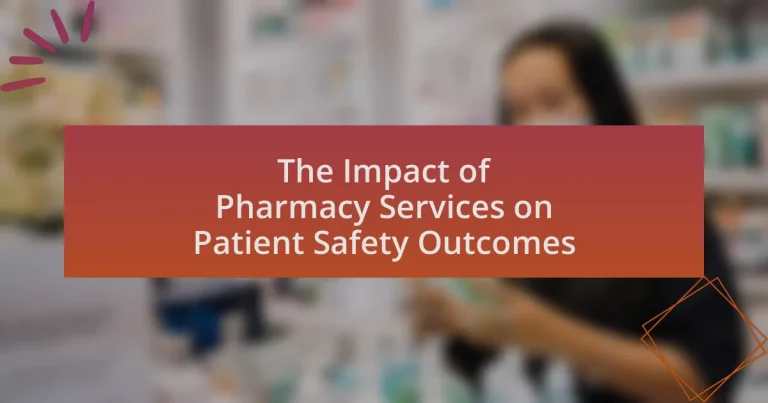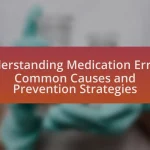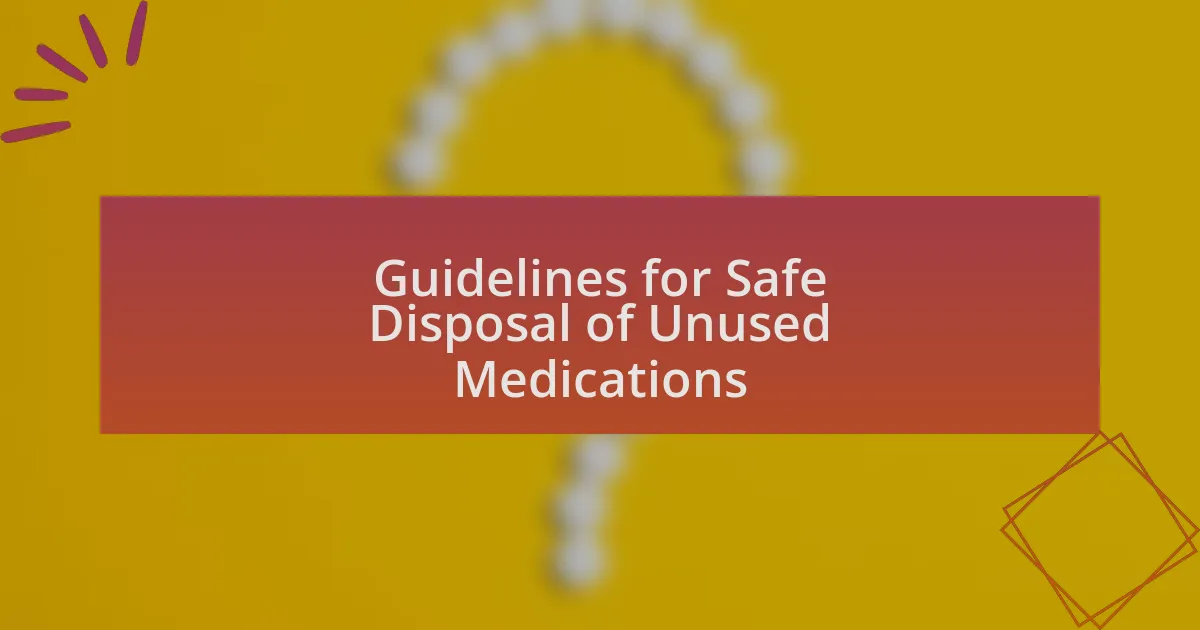Pharmacy services play a crucial role in enhancing patient safety outcomes by significantly reducing medication errors and improving medication management. Evidence shows that the integration of pharmacists into healthcare teams can lead to a 30% reduction in adverse drug events, with systematic practices such as medication reconciliation and patient counseling further minimizing risks. The article explores the specific contributions of pharmacy services to patient safety, the roles of pharmacists, and the impact of technology in medication management. It also highlights the importance of collaboration between healthcare providers and pharmacists, as well as the essential training required for pharmacists to effectively improve patient safety.
What is the Impact of Pharmacy Services on Patient Safety Outcomes?
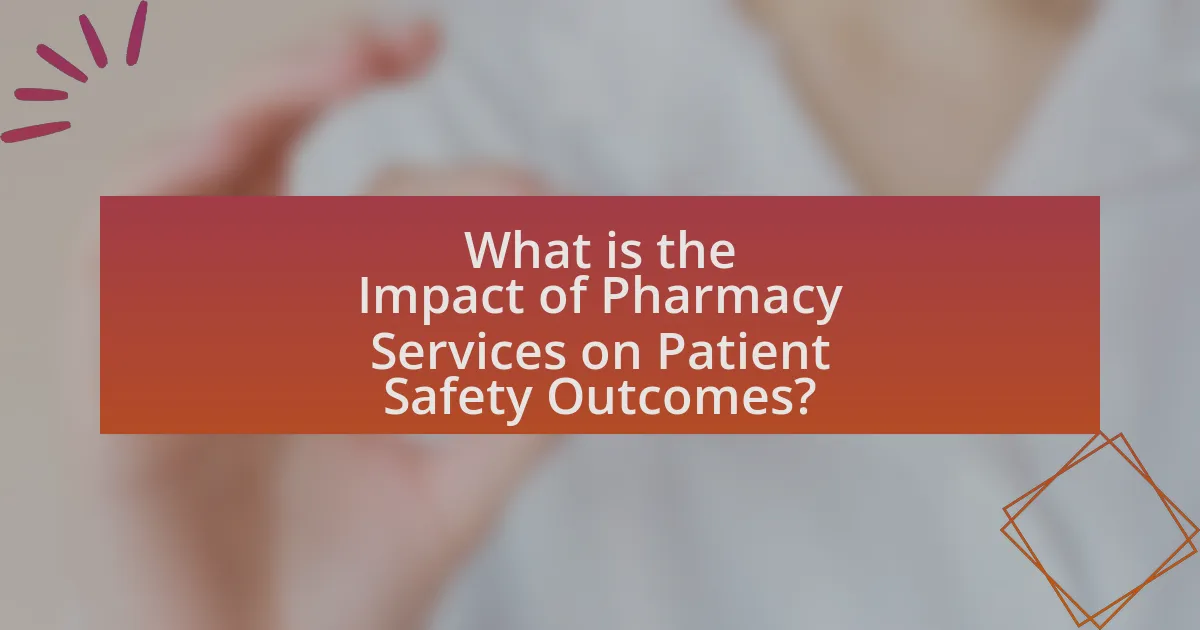
Pharmacy services significantly enhance patient safety outcomes by reducing medication errors and improving medication management. Studies indicate that the involvement of pharmacists in patient care leads to a decrease in adverse drug events, with one research showing a 30% reduction in medication errors when pharmacists are integrated into healthcare teams. Furthermore, pharmacists provide essential medication counseling, which improves patient adherence and understanding of their treatment regimens, thereby contributing to better health outcomes. The evidence supports that pharmacy services play a crucial role in ensuring safe medication use and optimizing therapeutic outcomes for patients.
How do pharmacy services contribute to patient safety?
Pharmacy services contribute to patient safety by ensuring accurate medication management and reducing the risk of medication errors. These services include medication reconciliation, which identifies and resolves discrepancies in a patient’s medication list, thereby preventing adverse drug events. According to a study published in the Journal of the American Pharmacists Association, implementing pharmacy-led medication reconciliation can reduce medication errors by up to 50%. Additionally, pharmacists provide patient education on proper medication use, which enhances adherence and minimizes the likelihood of misuse. This multifaceted approach by pharmacy services significantly enhances overall patient safety outcomes.
What specific roles do pharmacists play in enhancing patient safety?
Pharmacists play critical roles in enhancing patient safety by ensuring the safe and effective use of medications. They conduct medication reviews to identify potential drug interactions, verify dosages, and assess patient adherence to prescribed therapies. Studies show that pharmacists’ interventions can reduce medication errors by up to 50%, significantly lowering the risk of adverse drug events. Additionally, pharmacists provide patient education on medication management, which empowers patients to understand their treatments better and recognize side effects. This proactive approach not only improves medication safety but also enhances overall health outcomes.
How do pharmacy services reduce medication errors?
Pharmacy services reduce medication errors by implementing systematic checks and balances in the medication management process. These services include medication reconciliation, where pharmacists review and verify patient medication lists to identify discrepancies, thus preventing potential errors. Additionally, pharmacists provide patient education on proper medication usage, which enhances adherence and reduces the likelihood of misuse. Studies have shown that involving pharmacists in clinical decision-making can decrease medication errors by up to 50%, highlighting their critical role in ensuring patient safety.
Why is patient safety a critical concern in healthcare?
Patient safety is a critical concern in healthcare because it directly affects the quality of care and outcomes for patients. Ensuring patient safety minimizes the risk of harm, which can arise from medical errors, infections, and adverse drug reactions. According to the World Health Organization, medication errors alone can lead to significant morbidity and mortality, highlighting the importance of effective pharmacy services in preventing such incidents. Furthermore, studies indicate that improving patient safety can lead to better health outcomes, reduced healthcare costs, and increased patient satisfaction, reinforcing the necessity of prioritizing safety in healthcare settings.
What are the consequences of poor patient safety outcomes?
Poor patient safety outcomes lead to increased morbidity and mortality among patients. Specifically, adverse events such as medication errors, infections, and falls can result in prolonged hospital stays, higher healthcare costs, and diminished quality of life. For instance, a study published in the Journal of Patient Safety found that preventable adverse events contribute to approximately 400,000 deaths annually in the United States, highlighting the critical need for effective safety measures. Additionally, poor patient safety can erode trust in healthcare systems, leading to decreased patient satisfaction and reluctance to seek necessary medical care.
How does patient safety relate to overall healthcare quality?
Patient safety is a fundamental component of overall healthcare quality, as it directly influences patient outcomes and satisfaction. When healthcare systems prioritize patient safety, they reduce the incidence of medical errors, adverse events, and complications, which in turn enhances the effectiveness and efficiency of care delivery. For instance, studies have shown that hospitals with robust patient safety protocols experience lower rates of hospital-acquired infections and medication errors, leading to improved patient recovery times and reduced healthcare costs. Therefore, the relationship between patient safety and healthcare quality is integral, as high safety standards contribute to better health outcomes and a more reliable healthcare system.
What are the key components of pharmacy services that affect patient safety?
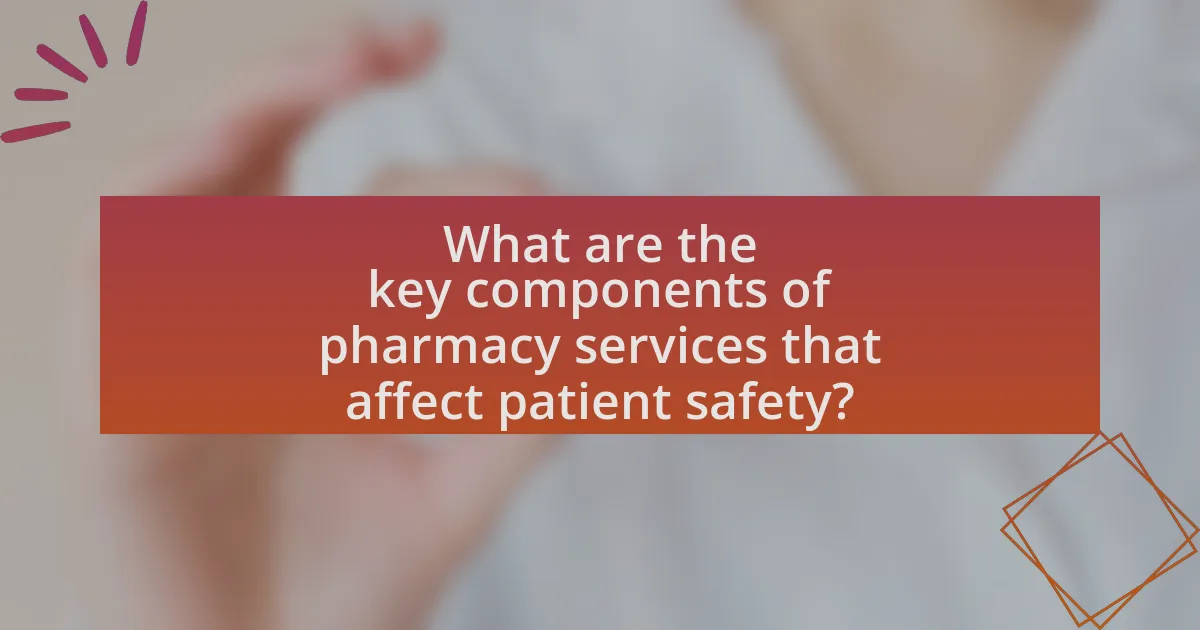
The key components of pharmacy services that affect patient safety include medication management, patient counseling, and medication reconciliation. Medication management ensures that patients receive the correct medications at the appropriate dosages, which reduces the risk of adverse drug events. Patient counseling provides essential information about medication use, side effects, and interactions, empowering patients to adhere to their treatment plans. Medication reconciliation involves reviewing and verifying a patient’s medication list during transitions of care, which helps prevent medication errors. These components collectively enhance patient safety by minimizing risks associated with medication therapy.
How do medication management and counseling improve patient safety?
Medication management and counseling significantly improve patient safety by ensuring appropriate medication use and minimizing adverse drug events. Effective medication management involves regular review of a patient’s medication regimen, which helps identify potential drug interactions, contraindications, and dosing errors. Counseling provides patients with essential information about their medications, including proper usage, side effects, and the importance of adherence. Studies indicate that comprehensive medication management can reduce medication errors by up to 50%, thereby enhancing overall patient safety.
What strategies do pharmacists use for effective medication management?
Pharmacists employ several strategies for effective medication management, including medication reconciliation, patient education, and adherence monitoring. Medication reconciliation involves reviewing a patient’s medication list at transitions of care to prevent errors and ensure continuity. Patient education focuses on informing individuals about their medications, including proper usage and potential side effects, which enhances understanding and compliance. Adherence monitoring utilizes tools such as pill organizers and follow-up consultations to track patient adherence to prescribed regimens. These strategies collectively contribute to improved patient safety outcomes by reducing medication errors and enhancing therapeutic effectiveness.
How does patient counseling impact adherence and safety?
Patient counseling significantly enhances medication adherence and safety by providing patients with essential information and support regarding their treatment. Effective counseling helps patients understand their medications, including proper usage, potential side effects, and the importance of adherence to prescribed regimens. Research indicates that patients who receive thorough counseling are more likely to adhere to their medication schedules, which in turn reduces the risk of medication errors and adverse drug events. For instance, a study published in the Journal of the American Pharmacists Association found that patient counseling improved adherence rates by up to 30%, demonstrating a clear link between counseling and improved safety outcomes.
What role does technology play in pharmacy services and patient safety?
Technology plays a crucial role in enhancing pharmacy services and ensuring patient safety by streamlining medication management and reducing errors. Automated systems, such as electronic prescribing and medication dispensing technologies, minimize the risk of human error, which is a significant factor in medication-related adverse events. For instance, a study published in the Journal of the American Medical Association found that electronic prescribing reduced medication errors by 55%. Additionally, technology facilitates better communication among healthcare providers, allowing for real-time access to patient medication histories and alerts for potential drug interactions, further safeguarding patient health.
How do electronic health records enhance medication safety?
Electronic health records (EHRs) enhance medication safety by providing comprehensive, real-time access to patient medication histories, which helps prevent adverse drug interactions and errors. EHRs facilitate accurate medication reconciliation by automatically updating prescriptions and dosages, ensuring that healthcare providers have the most current information. Studies have shown that the implementation of EHRs can reduce medication errors by up to 50%, as they include clinical decision support tools that alert providers to potential issues such as allergies or contraindications. This integration of information significantly improves patient safety outcomes by minimizing the risk of harmful medication-related incidents.
What are the benefits of automated dispensing systems?
Automated dispensing systems enhance medication management by improving accuracy, efficiency, and safety in pharmacy services. These systems minimize human error in medication dispensing, which is critical for patient safety; studies indicate that automated systems can reduce medication errors by up to 50%. Additionally, they streamline workflow by allowing pharmacists to focus on clinical tasks rather than manual dispensing, thus improving overall service delivery. Furthermore, automated dispensing systems provide real-time inventory management, ensuring that medications are available when needed, which contributes to better patient outcomes.
What evidence supports the impact of pharmacy services on patient safety outcomes?
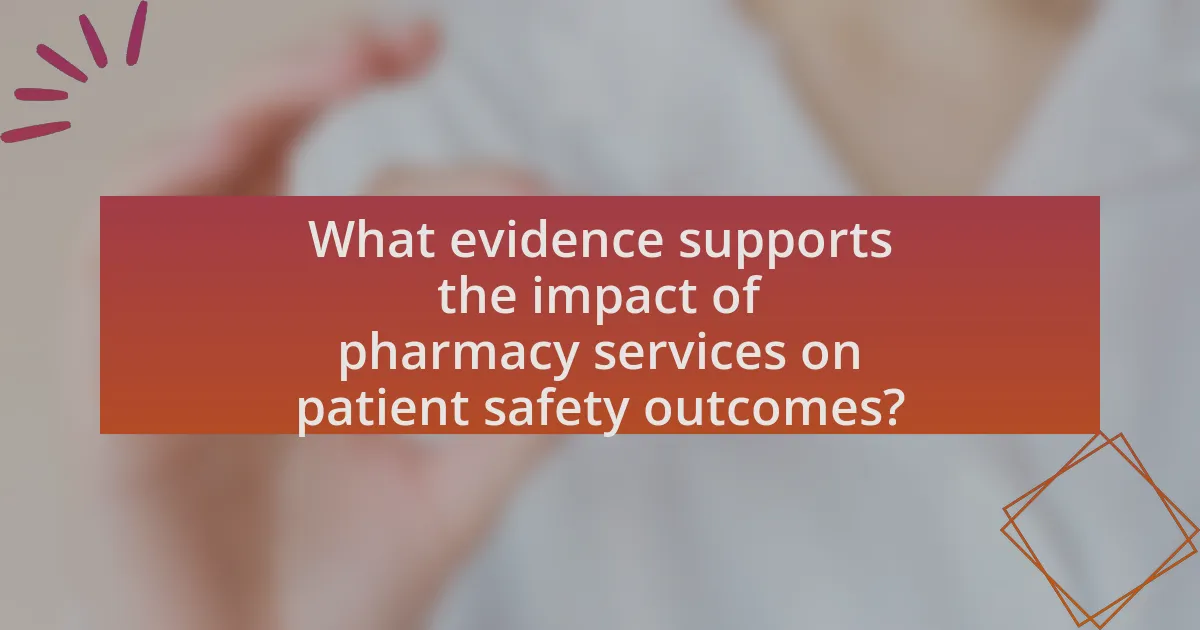
Pharmacy services significantly enhance patient safety outcomes, as evidenced by various studies demonstrating reductions in medication errors and adverse drug events. For instance, a systematic review published in the Journal of the American Pharmacists Association found that pharmacist-led interventions decreased medication errors by 50% in hospital settings. Additionally, a study in the Archives of Internal Medicine reported that medication reconciliation performed by pharmacists reduced adverse drug events by 30% during hospital transitions. These findings illustrate the critical role pharmacy services play in improving patient safety through effective medication management and error prevention.
What studies demonstrate the effectiveness of pharmacy interventions?
Studies demonstrating the effectiveness of pharmacy interventions include a systematic review by McGowan et al. (2017), which found that pharmacist-led medication reviews significantly reduced medication errors and adverse drug events in various healthcare settings. Another notable study by Bond et al. (2010) showed that pharmacist interventions in hospital settings led to a 66% reduction in preventable adverse drug events. Additionally, a randomized controlled trial by Zillich et al. (2005) indicated that pharmacist involvement in chronic disease management improved patient outcomes, including better control of hypertension and diabetes. These studies collectively provide strong evidence of the positive impact pharmacy interventions have on patient safety outcomes.
How do clinical trials measure the impact of pharmacy services on safety?
Clinical trials measure the impact of pharmacy services on safety by evaluating specific safety outcomes, such as medication errors, adverse drug reactions, and overall patient health status. These trials often utilize randomized controlled designs to compare groups receiving enhanced pharmacy services against those receiving standard care, allowing for a clear assessment of the services’ effectiveness. For instance, a study published in the Journal of the American Pharmacists Association demonstrated that pharmacy-led medication reviews significantly reduced the incidence of adverse drug events in elderly patients, providing concrete evidence of improved safety outcomes linked to pharmacy services.
What are the key findings from recent research in this area?
Recent research indicates that pharmacy services significantly enhance patient safety outcomes by reducing medication errors and improving adherence to treatment regimens. A study published in the Journal of the American Pharmacists Association found that implementing clinical pharmacy services in hospitals led to a 30% reduction in adverse drug events. Additionally, a systematic review in the International Journal of Clinical Pharmacy highlighted that pharmacist-led medication reconciliation processes decreased discrepancies in medication lists by 50%, thereby minimizing the risk of patient harm. These findings underscore the critical role of pharmacy services in promoting safer medication practices and improving overall patient safety.
How do pharmacy services vary across different healthcare settings?
Pharmacy services vary significantly across different healthcare settings, including hospitals, outpatient clinics, and community pharmacies. In hospitals, pharmacy services often include medication management, clinical consultations, and participation in multidisciplinary rounds, which enhance patient safety by ensuring appropriate medication use. Outpatient clinics typically focus on medication therapy management and patient education, aiming to optimize therapeutic outcomes and reduce adverse drug events. Community pharmacies provide medication dispensing, health screenings, and counseling, which contribute to medication adherence and preventive care. These variations are supported by studies showing that integrated pharmacy services in hospitals can reduce medication errors by up to 50%, while community pharmacy interventions have been linked to improved patient outcomes and reduced hospital readmissions.
What are the differences in pharmacy services in hospitals versus outpatient settings?
Pharmacy services in hospitals differ from those in outpatient settings primarily in their scope and focus. Hospital pharmacy services are typically more comprehensive, involving medication management for inpatients, including the preparation of sterile products, monitoring of drug interactions, and participation in multidisciplinary rounds to optimize therapy. In contrast, outpatient pharmacy services focus on dispensing medications, patient counseling, and managing chronic disease therapies, often with less direct involvement in acute care decisions.
Evidence supporting these differences includes the fact that hospital pharmacists are often integrated into patient care teams, which has been shown to reduce medication errors and improve patient outcomes, as highlighted in studies such as the one published in the American Journal of Health-System Pharmacy. Outpatient pharmacists, while also crucial, primarily engage in medication therapy management and patient education, which is essential for chronic disease management but does not encompass the same level of acute care involvement seen in hospitals.
How do community pharmacies contribute to patient safety compared to institutional pharmacies?
Community pharmacies contribute to patient safety by providing personalized medication management and accessible healthcare services, which are often more tailored than those in institutional pharmacies. Community pharmacists engage in direct patient interactions, allowing them to identify potential medication errors, assess patient understanding of their medications, and provide counseling on proper usage. Studies indicate that community pharmacies can reduce medication-related problems by up to 30% through these interventions, highlighting their role in enhancing patient safety. Additionally, community pharmacies often serve as a first point of contact for patients, facilitating timely referrals and follow-ups that further mitigate risks associated with medication therapy.
What best practices can be implemented to enhance the impact of pharmacy services on patient safety?
Implementing best practices such as medication reconciliation, patient education, and the use of clinical decision support systems can significantly enhance the impact of pharmacy services on patient safety. Medication reconciliation ensures that patients’ medication lists are accurate and up-to-date, reducing the risk of adverse drug events. Patient education empowers individuals to understand their medications, fostering adherence and awareness of potential side effects. Clinical decision support systems provide pharmacists with real-time data and alerts regarding drug interactions and contraindications, enabling informed decision-making. These practices collectively contribute to improved patient outcomes and safety in medication management.
How can healthcare providers collaborate with pharmacists for better outcomes?
Healthcare providers can collaborate with pharmacists by integrating pharmacists into the healthcare team to optimize medication management and improve patient outcomes. This collaboration allows for comprehensive medication reviews, which can identify potential drug interactions and ensure appropriate therapy adjustments. Studies have shown that such teamwork can lead to a reduction in medication errors and adverse drug events, ultimately enhancing patient safety. For instance, a systematic review published in the Journal of the American Pharmacists Association found that collaborative practices between pharmacists and healthcare providers significantly decreased hospital readmission rates and improved chronic disease management.
What training and education are essential for pharmacists to improve patient safety?
Pharmacists require comprehensive training and education in medication management, patient counseling, and safety protocols to improve patient safety. This includes obtaining a Doctor of Pharmacy (PharmD) degree, which covers pharmacology, therapeutics, and clinical practice. Additionally, pharmacists must engage in continuing education programs that focus on the latest safety guidelines and risk management strategies. Research indicates that pharmacists who participate in specialized training, such as medication therapy management and error prevention techniques, significantly reduce medication errors and adverse drug events, thereby enhancing patient safety outcomes.
